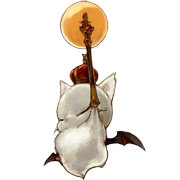|
Grand Fromage posted:In addition to what was said, it was collectively loving terrifying to Europe. The end of the Roman Empire was a milestone in and of itself, but also they were seen as the last guardians keeping the Turkish hordes from overrunning all of Europe. And the Ottomans did invade west, so it wasn't just a made up thing either. I like that this is so delightfully human; "The Romans are our last line of defense against the Muslim hordes! What? Help them? Don't be ridiculous. Anything outside of this line on this map is not my responsibility."
|
|
|
|

|
| # ? May 26, 2024 02:20 |
|
Namarrgon posted:I like that this is so delightfully human; "The Romans are our last line of defense against the Muslim hordes! What? Help them? Don't be ridiculous. Anything outside of this line on this map is not my responsibility." Well, in their own way they did try to "help". Sadly, every military conflict with the Ottoman Empire from the Fall of Adrianopel in 1365 until the First Siege of Vienna in 1529 was an endless string of disasters. Only with the retreat from the first siege did the seemingly unstoppable march of the Empire finally grind to a halt. And only after the second siege at the end of the 17th century did the Christian realms make any kind of progress against the Ottomans. So for almost 400 years the people of Europe just had to live with this large behemoth threatening them. Then it suddenly started to collapse. That's history for you.
|
|
|
|
I guess this is more of a medieval then ancient history question but Hell, they did crush Rome at last so it's somewhat relevant - what was so powerful about the Ottoman military that they were able to wreck poo poo like that?
|
|
|
|
DarkCrawler posted:I guess this is more of a medieval then ancient history question but Hell, they did crush Rome at last so it's somewhat relevant - what was so powerful about the Ottoman military that they were able to wreck poo poo like that? Discipline, mobility, numbers, gunpowder, patience (they almost always spent a long time raiding and weakening a region before invading) and religious zeal. Not to mention their amazingly adaptive strategy and tactics. Stuff that indirectly helped: use of slavery, excellent bureaucracy and the timar-system. Did I miss something? my dad fucked around with this message at 13:48 on Jun 30, 2013 |
|
|
|
my dad posted:Discipline, mobility, numbers, gunpowder, patience (they almost always spent a long time raiding and weakening a region before invading) and religious zeal. Not to mention their amazingly adaptive strategy and tactics. Stuff that indirectly helped: use of slavery, excellent bureaucracy and the timar-system. Religious zeal? That sounds fairly orientalist, considering the context. More circumstantially, I'd put it down to the Ottomans uniting the powerful Turkish emirates, and after Tamerlane facing mostly weak enemies. The East European Christian states were no match to the Turks, the Mamluks had collapsed etc. The Ottomans quickly built up a vast territory by defeating their weaker neighbours, but they didn't steamroll over Austria, Unified Russia or the Safavids.
|
|
|
|
Ras Het posted:Religious zeal? That sounds fairly orientalist, considering the context. Well, both sides had religious zeal. Since the first armies contesting the Ottomans were armies full of crusaders you could even argue Europeans had more "zeal" then the Ottomans. And still they got schooled by them fairly regularly. The Battle of Nikopolis is a good example: Never have French/Burgundian/Hungarian knights faceplanted that hard ever before and after. I even read about it in school -in our books it was just called the "Catastrophe of Nikopolis". Also they had the best and most advanced artillery by far, allowing them to conquer cities with astonishing ease. (After all, even the fortifications of Constantinople couldn't hold them off in the end: The last siege of the city ended after two months with an Ottoman victory.) All this changed with the military reforms of Oranje, which finally got the European militaries on even foot with the Ottomans. In simpler terms: The conflict with the Ottoman Empire started with the Empire expanding against enemies caught in different shades of stagnation, but during the four centuries of war both sides slowly exchanged places: The Empire grew complacent and slipped into stagnation itself, while the European states slowly adapted until they could fight Ottoman armies without getting humiliated. Libluini fucked around with this message at 14:19 on Jun 30, 2013 |
|
|
|
Ras Het posted:Religious zeal? That sounds fairly orientalist, considering the context. To clarify, I meant "religious zeal" in a way used to describe the Spanish conquests in America - a convenient excuse for ever-continuing expansion, not a reason on its own. The Ottomans were quite capable of being tolerant when it suited them - the final nail in the coffin of the Crusader cavalry at Nicopolis was a flank attack by Christian cavalry lead by the Sultan's Christian brother-in-law, for example. Ras Het posted:More circumstantially, I'd put it down to the Ottomans uniting the powerful Turkish emirates, and after Tamerlane facing mostly weak enemies. The East European Christian states were no match to the Turks, the Mamluks had collapsed etc. The Ottomans quickly built up a vast territory by defeating their weaker neighbours, but they didn't steamroll over Austria, Unified Russia or the Safavids. I don't quite agree with you here. Eastern European countries were no match for the Turks, yes, but they were certainly not the pushovers you make them sound like. And the Ottomans got quite close to steamrolling Austria on several occasions, getting as far as Vienna more than once. It took the combined might of the Habsburgs, Venice, Holy Roman Empire, Poland and a few other countries to stop the Ottoman advance in the West. edit: This has nothing to do with ancient history, so I'll stop derailing. edit2: vvvv This is also a good point. my dad fucked around with this message at 14:54 on Jun 30, 2013 |
|
|
|
Libluini posted:And only after the second siege at the end of the 17th century did the Christian realms make any kind of progress against the Ottomans. So for almost 400 years the people of Europe just had to live with this large behemoth threatening them. Then it suddenly started to collapse. That's history for you. That's treating Europe and the Muslim world as two monolithic entities who were locked in a conflict for hundreds of years, when reality is more complex than that. France for one was pretty happy to establish an alliance with the Ottomans to try and flank Charles V's Habsburg dynasty (ruler of Spain, Italy, the Netherlands, Burgundy and Holy Roman Emperor to boot) just 80 years after the fall of Constantinople. The alliance was pretty solid until the French revolution, too.
|
|
|
|
my dad posted:I don't quite agree with you here. Eastern European countries were no match for the Turks, yes, but they were certainly not the pushovers you make them sound like. And the Ottomans got quite close to steamrolling Austria on several occasions, getting as far as Vienna more than once. It took the combined might of the Habsburgs, Venice, Holy Roman Empire, Poland and a few other countries to stop the Ottoman advance in the West. What I meant that after... What'd you have there, Bulgaria, Serbia? After those and Rome folded, and after the Turks were unified under Ottoman rule, they already had a very large and fairly stable state. So after that you're talking of a very significant player in the geopolitical scene, and them advancing deeper into Central Europe wasn't some sort of out of the blue shock. It's like how Moscow wouldn't've been a match for Poland-Lithuania, but after they unified the weak Russian principalities, they had a legit empire.
|
|
|
|
Libluini posted:Also they had the best and most advanced artillery by far, allowing them to conquer cities with astonishing ease. (After all, even the fortifications of Constantinople couldn't hold them off in the end: The last siege of the city ended after two months with an Ottoman victory.) All this changed with the military reforms of Oranje, which finally got the European militaries on even foot with the Ottomans. Constantinople's walls having been built centuries before, they were designed to hold off enemy soldiers climbing ladders, not to withstand bombardment. Although that's really just the nail in the coffin. There was also Mehmed II's personal desire to conquer the city; maybe a guy who didn't care would have attacked somewhere else.
|
|
|
|
Since the fall of Constantinople was four decades before Columbus went off into the Americas for the first time, anyone that was in their twenties for the first event would be in their sixties for the latter. I wonder if any writers ended up writing about both, and the symbolic nature of the death of the ancient world and the "discovery" (though vikings did it first) of the new world.
|
|
|
|
There's one story from the fall of Constantinople that I think speaks volumes about the attitude of the West. A world-class cannonmaker from Hungary named Urban offered his services to the Emperor for a large fee. Since at this point the Emperor was stripping buildings of their lead roofing tiles to raise money, he couldn't meet Urban's price. Urban subsequently went to the Sultan, who paid him handsomely and made the most of his skills at building huge bombards able to knock holes in the walls of Constantinople. Even then, faith and religious solidarity didn't pay the butcher's bills. It was probably small comfort to the Christians that Urban was blown to atoms during the siege when one of his cannons misfired and exploded.
|
|
|
|
Namarrgon posted:So how about the Roman emperor's homes? Was their anything like an imperial palace or did the emperors have the tendency to barricade themselves in their patrician mansions? Some of their homes still exist!  Might be a repost, but here is Diocletian's palace as it originally looked in 305 AD. During the middle ages it became the nucleus of a small town and much of its structure has survived.  The town of Split, Croatia. Note the walls and towers have survived. Apparently the Diocletian originally filled the place with Egyptian sphinxes and a few are still kicking around the city.
|
|
|
|
I think a few palaces are left standing in Rome as well, including Augustus'. I believe Nero's golden palace was found in the 1500's when somebody accidentally fell in it. And Capri is still covered in the remains of Roman Villa's, including Tiberius', along with his grotto, which I forgot the name of. I think Hadrian had one of the coolest ones: http://en.wikipedia.org/wiki/Hadrian%27s_Villa drat Europeans, particularly Italians, are so drat lucky they have poo poo like this everywhere. It's one of the things that sucks about being an American, no cool Ancient ruins. Yes I know (and have been to) ancient Native American sites but they didn't leave anything behind like the Colosseum.
|
|
|
|
How exactly do you fall into a palace? Was it buried underground or something?
|
|
|
|
The Domus Aurea, Nero's Golden Palace, was so gaudy that his successors filled it with dirt and rubble and built the Colosseum, Bath's of Titus, Bath's of Trajan, and the Temple of Venus and Rome were built on top of it. Some Romans believed that Nero started the great fire in 64 AD that burned down many houses in order to build the Domus Aurea, though I believe it's generally accepted now that he most likely didn't start the fire. In the 14th century a citizen of Rome fell through the Esquiline hill and found himself in what turned out to be the Domus Aurea. Most old Italian cities seem to be built on top of Roman buildings. http://en.wikipedia.org/wiki/Domus_Aurea edit: Can you imagine falling into a loving palace though? I wish I lived somewhere that I could accidentally fall into some old rear end ruins.
|
|
|
|
I believe some of the best examples of artwork of that period was found in the Palace at the time, and that Renaissance era artists would organize being lowered down to check out the work of the ancient Masters. But sadly the exposure to the air caused the formerly preserved artwork to quickly decay after a millennium and a half of preservation.
|
|
|
|
Mustang posted:drat Europeans, particularly Italians, are so drat lucky they have poo poo like this everywhere. It's one of the things that sucks about being an American, no cool Ancient ruins. Yes I know (and have been to) ancient Native American sites but they didn't leave anything behind like the Colosseum. Well, the North Americans didn't.  
|
|
|
|
DarkCrawler posted:Well, the North Americans didn't. What kind of bloody-minded culture builds its cities on the top of a mountain? Oh.
|
|
|
|
Yeah, most of the ruins left by native americans are south of the Rio Grande at least. All we have in the U.S. are some big ol' piles of dirt. Not that it makes those ancient cultures any less valid or anything, it's just not as cool as an ancient temple.
|
|
|
|
SlothfulCobra posted:Yeah, most of the ruins left by native americans are south of the Rio Grande at least. All we have in the U.S. are some big ol' piles of dirt. So I read that wikipedia-entry and I have a question: What the gently caress? Why are there so many cases of "destroyed for new construction"? This is like Egypt going "Welp, those fancy old pyramids sure were nice, but we needed a new apartment complex, so they had to go."
|
|
|
|
Libluini posted:So I read that wikipedia-entry and I have a question: A fuckton of old stuff in Europe has been destroyed by succeeding cultures not caring about old monuments, there's nothing especially new about that. What's special about North America is that respect for extinct indigenous cultures there came much later. Europeans were still destroying ancient sites for various reasons, and would have dismantled the Great Pyramid and taken it home if they could, but at least from the rennaissance to mid-1800's they began recognizing the value of local monuments. Either because "the Ancients  " or because of rising nationalism. But until then ancient structures were destroyed for construction materials and old places of worship were desecrated by Christians. " or because of rising nationalism. But until then ancient structures were destroyed for construction materials and old places of worship were desecrated by Christians.Meanwhile, in North America the new inhabitants considered the aboriginals as savages. Compare to how Aztec art was melted for bullion. There's a rather well preserved late medieval castle nearby, just century ago people were planning to tunnel a railroad right through it... 
|
|
|
|
Nenonen posted:A fuckton of old stuff in Europe has been destroyed by succeeding cultures not caring about old monuments, there's nothing especially new about that. What's special about North America is that respect for extinct indigenous cultures there came much later. Europeans were still destroying ancient sites for various reasons, and would have dismantled the Great Pyramid and taken it home if they could, but at least from the rennaissance to mid-1800's they began recognizing the value of local monuments. Either because "the Ancients You just wait until a couple of centuries down the line when people are talking about our generation's savage deconstruction of all those priceless brutalist buildings.  The wealth of materials some of the ancient structures had on them shouldn't really be understated; stuff like marble is not cheap, and neither is marble that the Romans shipped halfway across the known world just because. Nobody's using that poo poo anymore, it'll save me a fortune, why should I have to mine out new materials?
|
|
|
|
Fancy castles will seem a lot less appealing if that drat thing adds a 20 minute drive to your commute each way.
|
|
|
|
ya sometimes I wonder if preservation goes too far when surely the stuff we're preserving so carefully was built on something they bulldozed and blasted apart to make room, and its . Obviously that doesn't apply for something like the pantheon or pyramids but random castle #12 can maybe be removed for something modern.
|
|
|
Libluini posted:So I read that wikipedia-entry and I have a question:
|
|
|
|
|
Xguard86 posted:ya sometimes I wonder if preservation goes too far when surely the stuff we're preserving so carefully was built on something they bulldozed and blasted apart to make room, and its . Obviously that doesn't apply for something like the pantheon or pyramids but random castle #12 can maybe be removed for something modern. Hey man how do you know that there wasn't a bunch of pyramids and they removed most of them with the same rationale? Or maybe inside that one castle is a hidden repository of literature or artifacts? Or a dragon!
|
|
|
|
Libluini posted:So I read that wikipedia-entry and I have a question: A lot of it was also "I need to build a new building or fence or something, and oh look, a nice pile of evenly shaped stones that nobody is using right now. I might as well commandeer those and put them to use."
|
|
|
|
SlothfulCobra posted:Yeah, most of the ruins left by native americans are south of the Rio Grande at least. All we have in the U.S. are some big ol' piles of dirt. Uhm 
|
|
|
|
Those buildings are anthropologically fascinating, but not architecturally impressive. It's difficult to compare these to the kind of wondrous relics like the Colosseum, the Great Wall, or the Pyramids. This is essentially a factor of the relatively small population that lived in North America - even prior to the European pandemics. The indigenous population of the American continents predominantly lived in the warm regions of Central America and South America - which is also where the enduring American cultural monuments were built.
|
|
|
|
WHAT A GOOD DOG posted:Hey man how do you know that there wasn't a bunch of pyramids and they removed most of them with the same rationale? You joke but one pyramid is known to have been taken apart almost completely.
|
|
|
|
Azathoth posted:It's a huge shame and should be a source of national embarrassment, but it's not shocking that it's happening. Look at what's happening in Central America with the Mayan sites being destroyed for road construction materials. The same thing would be happening in Egypt if their archaeological sites weren't such a huge source of tourist money. Want to know what happened in my old home town a few years ago after they found some random Roman junk while repairing one of the main roads? They stopped the construction immediately and called in archaeologists. Only after everything worthwile was carefully excavated did the work continue. The best part? Everyone was kinda OK with it. If we had simply bulldozed over this stuff, everyone would have flipped their poo poo, though. Now compare and contrast. Xguard86 posted:ya sometimes I wonder if preservation goes too far when surely the stuff we're preserving so carefully was built on something they bulldozed and blasted apart to make room, and its . Obviously that doesn't apply for something like the pantheon or pyramids but random castle #12 can maybe be removed for something modern. Luckily most of our castles still belong to the odd noble or are tourist magnets themselves, so at least our castles will survive. If everyone else pulls down their castles, the survival chances of our castles will maybe even go up, who knows?  Kaal posted:Those buildings are anthropologically fascinating, but not architecturally impressive. It's difficult to compare these to the kind of wondrous relics like the Colosseum, the Great Wall, or the Pyramids. This is essentially a factor of the relatively small population that lived in North America - even prior to the European pandemics. The indigenous population of the American continents predominantly lived in the warm regions of Central America and South America - which is also where the enduring American cultural monuments were built. I have to disagree, they look at least as fascinating as old Mesopotamian ruins to me. Nenonen posted:There's a rather well preserved late medieval castle nearby, just century ago people were planning to tunnel a railroad right through it... Now that's weird. But then I live somewhere were a century ago something like this would have been unthinkable. On account of the nobles owning the castle still having political power.
|
|
|
|
Kaal posted:Those buildings are anthropologically fascinating, but not architecturally impressive. I beg to differ. Considering what they were built with (both tools and materials), I do find them impressive. I mean, just look at that 4-story tower.
|
|
|
|
Zopotantor posted:I beg to differ. Considering what they were built with (both tools and materials), I do find them impressive. I mean, just look at that 4-story tower. It's no Acropolis.
|
|
|
|
Yeah are you kidding me that place looks awesome nestled underneath a massive mountain.
|
|
|
|
What were Byzantine-Chinese interactions like? Also, how were the various incarnations of Roman governments viewed by the Chinese? How did the Romans/Byzantines view the Chinese?
|
|
|
|
There weren't any government to government interactions, so the answer to the latter questions is that they didn't. There were missions (traders usually) that went back and forth very occasionally, but neither had a good understanding of the other. They were just sort of aware of some other big empire at the other end of the continent.
|
|
|
|
Even if there weren't governmental interactions, did any traders or explorers leave any remarks about what they saw or thought?
|
|
|
|
A fun chapter in the expansion of the Ottomans is when Cossacks tried to voluntarily join the Ottoman Empire in the 17th century (https://en.wikipedia.org/wiki/Great_Turkish_War):quote:After Bohdan Khmelnytsky's rebellion, when the Tsardom of Russia acquired parts of Eastern Ukraine from the Polish–Lithuanian Commonwealth, some Cossacks stayed in the southeast of the Commonwealth. Their leader, Petro Doroshenko, wanted to connect the rest of Ukraine with the Ottoman Empire, starting a rebellion against Hetman (Polish army commander) John III Sobieski. The Sultan Mehmed IV, who knew that the Polish–Lithuanian Commonwealth was weakened due to internal conflicts, attacked Kamianets-Podilskyi, a large city on the border. Hoffman's "With Fire and Sword" is about this. Well worth watching for history buffs. https://en.wikipedia.org/wiki/With_Fire_and_Sword_(film).
|
|
|
|

|
| # ? May 26, 2024 02:20 |
|
Ahhh man, I just found out how Aurelian's career ended  Sometimes I wonder how the hell the Roman Empire lasted as long as it did.
|
|
|






























 Yes, it's like a lava lamp.
Yes, it's like a lava lamp.






